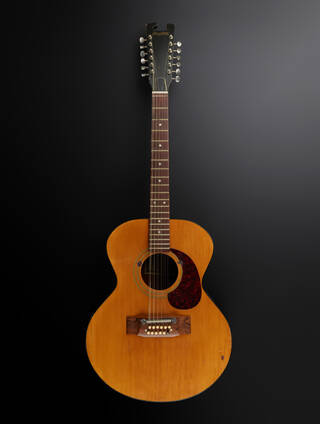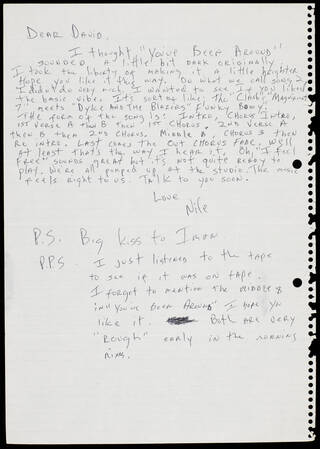David Bowie’s 15th studio album, Let’s Dance, released in 1983, remains his best-selling. Its sound was heavily influenced by its producer Nile Rodgers, who, with his band Chic, had created some of the biggest-selling hits of the disco era. From the 1980s onwards, Rodgers has helped to shape celebrated pop records – including Madonna’s era-defining album Like a Virgin and, more recently, Beyoncé’s acclaimed 2023 album Renaissance.
It was just a joy working with [Nile]. His unbridled enthusiasm for a project was contagious, to say the least. And his unshakeable belief in the potential of the song Let’s Dance. Prophetic. I must be honest and tell you that I never got it. Even when it was all over the airwaves, I just didn’t see it. But, Nile, as I played the first few notes of the chorus, virtually screamed, “Oh my God! That’s it! We have a smash!” I seriously reconsidered our working together momentarily.
David Bowie’s biggest hit: Nile Rodgers breaks down ‘Let’s Dance’
Nile Rodgers: I was staying at David’s house in Switzerland, and frankly, I was asleep. He walked into my bedroom and said, “Nile, darling, I think this is a hit.” I went, “Oh, cool, man. Let me hear it.” He was playing it on a 12-string guitar with only six strings on it. Ding ding ding ding…
“Hmm. David, what do you call that?”
“Let’s Dance.”
“Huh? Why do you call it Let’s Dance?”
“Well, it’s a song based on the dance that people do when they first encounter another person – or they’re trying to impress them.”
“David, I come from dance music. Can I do an arrangement?”
He flipped out when I said that, because I knew that David, in his heart, was a jazzer. The first night we met, we did nothing but talk about jazz. And the more avant-garde, the happier he seemed. I would always try and one-up him:
“Have you heard this record?”
“Yeah. But have you heard this song by Eric Dolphy?”
“Oh, wait a minute – did you hear the underground bootleg stuff from Stockholm?”
We were just going at it. So when I said: “Can I do an arrangement?” he sort of lit up. He was thinking I was going to turn it into something like an Oliver Nelson big band. I don’t know what he thought when he heard the word “arrangement”, but I knew he would associate that word with jazz – and that would give me at least a little time.
I got on the phone immediately and called all the people I knew who were friends with David. I just had to know if he was playing a trick on me. Because what he had played for me was completely contrary to what we had decided we would do.
Before we did the Let’s Dance album, David and I went around pining for vibe and spirit and where we were going to be coming from artistically. In those days, you had to go where the music was. You couldn’t call the radio station and say: “Hey, play these 50 songs for David and myself.”
We had to go to a place that had a big archive. We went to the museum at the Library of the Performing Arts. We went to a place called the Archives of Contemporary Music. We went to the head of Atlantic Records, Jerry Wexler’s house, because we knew he had an incredible record collection.

What we had settled on – or at least what I believed we had settled on – was this sort of cool mix of R&B-meets-funk-meets-dance music that would be of the current zeitgeist, if you will. But we would be on the leading edge. So when he called the first song Let’s Dance, I was like, “Oh, boom! He got it. He’s got the concept.”
But what he played was the antithesis of that concept. So I thought to myself: OK, he’s trying to test me. He wants to see if I’m going to go: “Oh, Mr Bowie, you’re so great, man. I’m really happy to be working with you.” But in fact, everyone I called said: “No, man, he’s not that kind of person. If he says he thinks that it’s a hit, he’s being really sincere.” And then I went: Oh my God. What are people going to think when we come out with a song going, ding ding ding ding… let’s dance… ding ding ding ding?
I wrote out an arrangement for two guitars, bass and drums, because I knew that if the vibe was in the rhythm section, that’s all I needed to hear. We got to the recording studio – which was owned by the band Queen – and I said: “David, sing exactly what you sang in my bedroom, but sing it over this music.” I never played it to him beforehand. He only heard it for the first time when I heard it for the first time. I’d heard it in my head as an arranger, but I never really heard it until we were in the recording studio and we played it.
We didn’t know any of the musicians. I asked the owner of the Montreux Jazz Festival, Claude Nobs, to send me three jazz musicians who could read music really well and send them to the studio. “We’d pay them double. Don’t worry about it – it’s totally legit.” We just needed them for a demo session.

I counted the song off, and we did the little dominant pyramid thing… Dah… Daaah… Daaaaaaah. I started playing: dink dink dink dink… As soon as we played that, I screamed. I could tell right away that it was a smash, because if the first part of it sounded like that, I knew that what was coming up in the arrangement was going to be mega.
Like I said, I had come from dance music. My band Chic was all about dance music. It was all about building up to the breakdown. And I could not wait to get to the breakdown on Let’s Dance because – unlike any other breakdown that I’ve ever done – the Let’s Dance breakdown is a jazz breakdown.
The guys are now battling the trumpet and the pocket trumpet and the saxophone. It’s a sonic groove breakdown. David was really happy, and I remember this like it was yesterday. I said: “Do you think this shit’s happening? Wait till you hear my guys play it.” I knew once we got back home and it was the people that I played with, playing my arrangements, it was going to be killer.
Find out more about the David Bowie Centre at V&A Storehouse.
Be the first to get content like this, unlimited free entry to exhibitions and a great range of benefits when you become a V&A Member.


